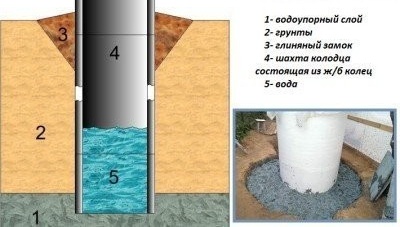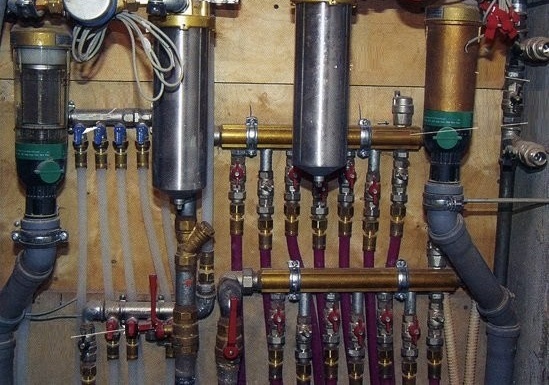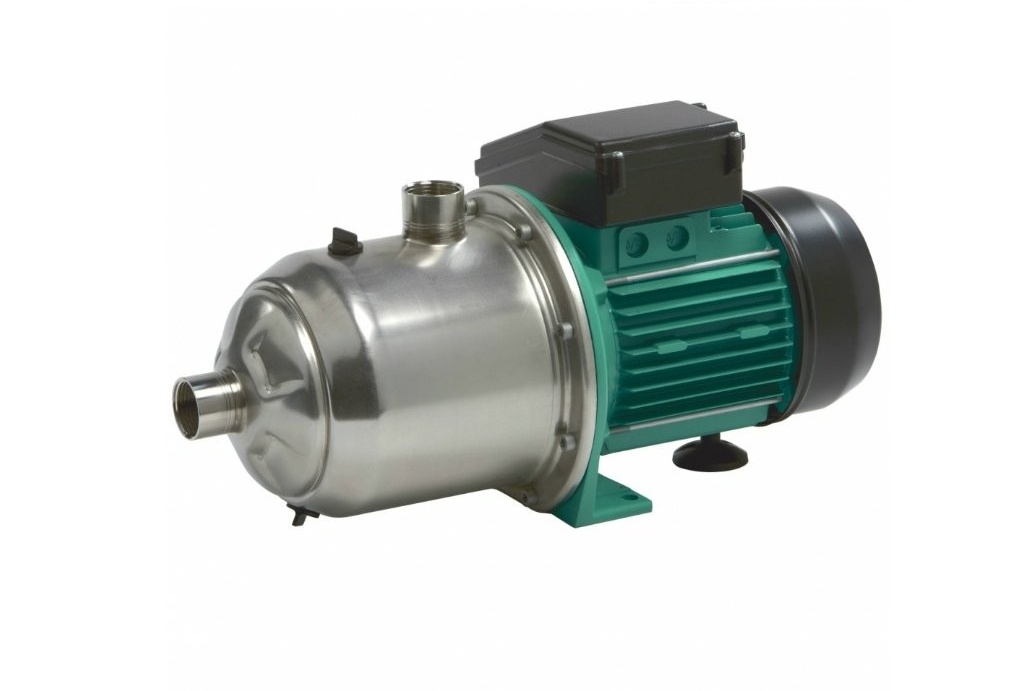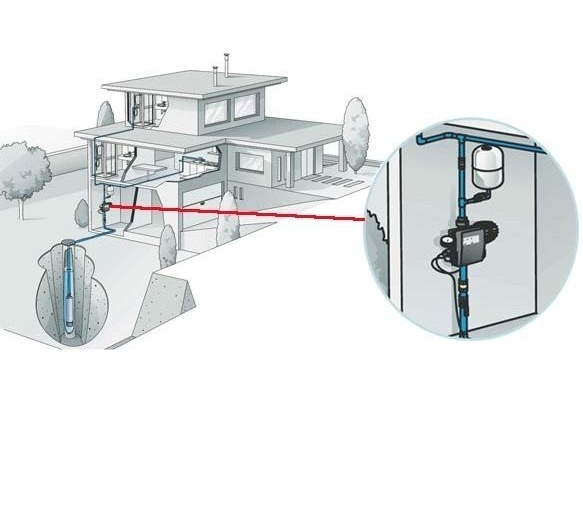Water supply device for a country house from a well: general tips and technological nuances
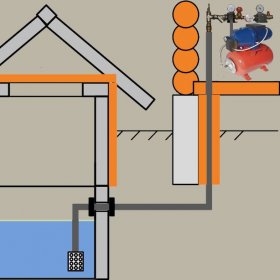
Since it is impossible to connect a country house to a centralized water supply, owners of private houses and summer residents have to independently solve the issue of autonomous water supply. There are three options for implementing this task: to use water from natural reservoirs, to organize the supply of water from a well or from a well. A pond or a river near the house is infrequent, so it remains to decide what is better to equip - a well or a well. Of the existing options, experts consider the water supply of the country house from the well preferable and there are a number of reasons in favor of this method.
Content
Benefits of Well Water
Well water supply is widely used for suburban private houses and cottages, and here's why:
- digging a well is much cheaper than drilling a well;
- anyone with the proper skills will be able to dig a well with his own hand;
- a well-constructed well will provide water for many years, and completely free of charge (not counting, of course, the cost of supplying water to the house);
- dig a well without official permission.
It should be noted, however, that, in comparison with water from a well, well water, due to its close occurrence to the earth's surface, can contain quite a lot of impurities. It is quite suitable for technical needs and watering, but in order to be able to use it for drinking, it is advisable to clean the water by installing a filter system. In addition, the well needs periodic cleaning (experts recommend conducting it at least once a year).
Well system technology
The whole process consists of:
- development of a specific water supply scheme;
- digging trenches for the pipeline, caissons;
- selection of pumping equipment and its installation;
- water treatment - installation of filters;
- laying the pipeline from the well to the house;
- installation of water heating equipment, dishwashers, washing machines.
Usually in an autonomous circuit private house water supply a pump or pumping station for water intake is turned on. They are installed in the house, in a special utility room or directly above the well - in a caisson. The pump is connected by a pipe to the well. With it, water is pumped into the accumulator, and from it pipes diverge to all consumers in the house.
If water is consumed in the house, for example, in the bathroom or in the kitchen sink, the pressure in the system begins to gradually decrease. When the pressure level reaches 2.2 bar, the pressure switch trips and turns on the pump. He again begins to pump water into the accumulator until the pressure reaches 3 bar. Pressure switch trips and the pump switches off again.

The water supply scheme from the well for any private house is carried out individually, depending on the purpose of the use of the water supply - exclusively for drinking water or also for watering the garden, washing the car, for livestock, poultry, etc.
Read also our material about other options for autonomous water supply of a private house:https://aquatech.tomathouse.com/en/santehnika/snaruzhj/vodoprovod-v-chastnom-dome-svoimi-rukami.html.
Choosing a place for the future well
The initial stage of the water supply device is well construction. It is recommended to carry out work from June to September: in the hot season, the level of groundwater occurrence is minimal. Determine a place for a future well You can use old-fashioned old-fashioned methods (for example, using vines), or find out all the information about the location of a water layer from neighbors who have their own wells.
Some restrictions should be taken into account: cesspools, toilets, compost piles, septic tanks and other pollution sources should not be located within a radius of 50 m from the well. The well should also not be located very close to the house, so that washing out the sand does not lead to a shift in the foundation. Once the site for the well is selected, you can begin designing the water supply.
The project of water supply of a country house from a well, drawing up a piping layout diagram, the selection and installation of pumping equipment, as well as the launch of a water supply system is best left to professionals, since this is a serious matter that requires special knowledge. In the meantime, the project is being developed, you can begin to dig a well.
Rules for the construction of a well made of concrete rings
The simplest and most reliable option is a well with reinforced concrete rings. Rings will prevent the collapse of the soil, will prevent the runoff of surface water inward. On a flat ground with a shovel, we dig a hole with a diameter 10-20 centimeters larger than the diameter of the ring. We dig to a depth of 10 cm less than the height of the ring (it usually has a height of 90-100 cm). We put the first ring in the pit, at least 3 connecting brackets are installed on its end.
We dig further to a depth of one ring, we dig out the earth and send it up. Lowering the first ring, we install the second in the brackets. We make a hole for the water pipe in it. According to the rules, the diameter of the hole should be 1.5 times larger than the diameter of the pipe.

A well made of special reinforced concrete rings is the most convenient and simple option of providing water to a country private house or cottage
We continue to dig and install new rings until the moment when the water begins to arrive intensively. This occurs approximately after the installation of 6-8 rings. The number of fontanels should be at least three. We go down another half meter, pumping out the incoming water with a pump.
After excavation, close the well shaft and leave for a day to find out the water level. Well, if it is more than 1-1.5 m. We pump out all the water and put small stones on the bottom, then a layer of crushed stone of 30-50 cm, which will play the role of a filter. We close the gaps between the concrete rings with cement-sand mortar. The well should again be filled with 1.5 rings.
Features of connecting pumping equipment
Water supply from a well involves extracting water from it using a pumping station, and its subsequent distribution throughout the house. Pumping equipment is conveniently located in the house, and even better in the utility room. The temperature in it should not be below +2 degrees in winter.
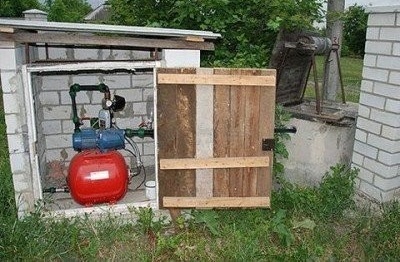
The pump station can be located in the utility room, but under the condition that in winter the temperature in it does not drop below +2 degrees C
Read also the article on how to properly make water in a private house:https://aquatech.tomathouse.com/en/santehnika/snaruzhj/vodoprovod-v-chastnom-dome-svoimi-rukami.html.
From the well to the house, we dig a trench with a depth below the level of soil freezing, lay the pipe on the bottom.
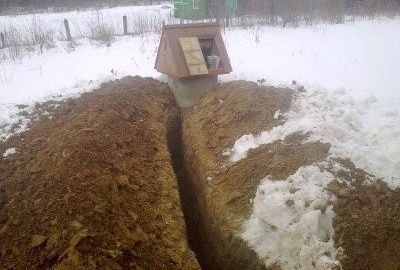
From the well to the house, a trench is dug to a depth below the level of soil freezing, a pipe is laid at the bottom
Pipes come from different materials - from steel, metal-plastic, copper, etc. You need to choose according to the necessary characteristics and, of course, in accordance with the budget. Plastic pipes are convenient in that they bend. We withdraw the pipe through the hole in the well ring and, bending it, lower it into the water, not reaching 30-40 cm to the bottom of the well. Inside it, insert the strainer.

The pipe is led out through a hole in the concrete ring, bent and lowered into water, not reaching 30-40 cm to the bottom of the well
We pump out all the water again, drive a pin into the bottom of the well, to which we attach the pipe. Now we can close the hole in the pipe ring with cement mortar. We dig in the trench and make a clay castle around the well to a depth of 40 centimeters with a thickness of 50 centimeters and a radius of 150 cm. This measure is necessary to prevent the entry of ground and rain water into the well.
To correctly choose a pumping station, you need to know what characteristics our well has. Conventional pumps lift water from a depth of 9 meters to 40 meters. But if the well is removed from the house, then it is better to purchase a self-priming centrifugal pump equipped with an external ejector - it lifts water from the well up to 45 meters deep.
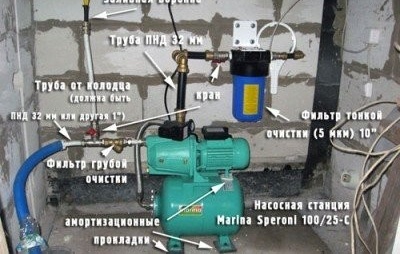
The selection and installation of pumping equipment, its connection, as well as the launch of the water supply system is better to entrust to specialists so as not to make mistakes
Before entering the pump, we install a check valve and a coarse water filter, and a fine filter after the pump station. We connect the manometer, then the pressure switch and all other devices. We make internal wiring to the points of water consumption - bath, sinks, toilet, washing machine. At the end we connect the pump station to the control panel.
You will also find useful material about the device and the principle of operation of the accumulator:https://aquatech.tomathouse.com/en/vodosnab/document/gidroakkumulyator-dlya-vodosnabzheniya.html.
That's all: a little work, patience and material costs, as well as a great desire, and water supply to a summer house or a private country house from a well dug by a do-it-yourself well are provided for many years to come.
